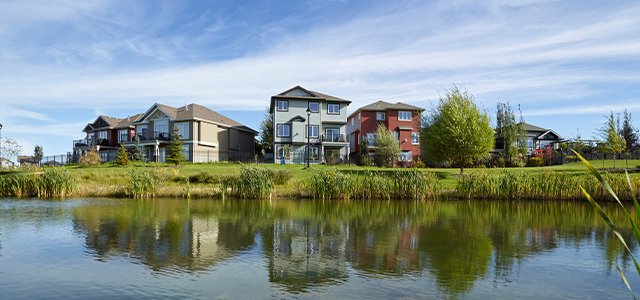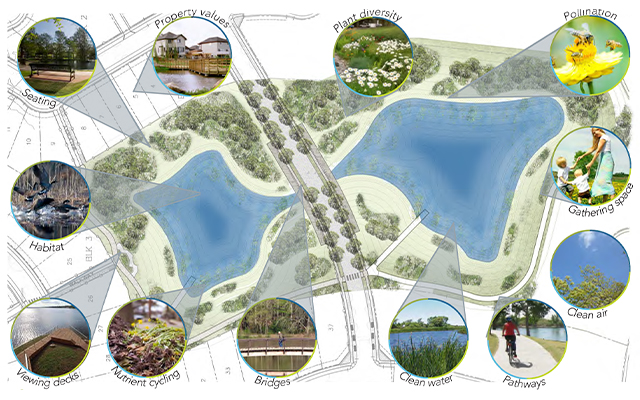Stormwater ponds have become a common fixture in new communities, often encircled by a walking path or enhanced by benches, docks and lookout points. In addition to providing natural scenery, they play an important role in managing the excess stormwater that flows through our communities.
What Does a Storm Pond Do?
As communities are developed, permeable soil (that would typically absorb precipitation) is replaced by impermeable surfaces such as houses, roads and sidewalks. During a storm, the rain has to go somewhere – and it must be kept away from your home’s foundation.
Instead of dripping into your basement, the runoff water (from rain or melting snow) pools in a stormwater pond. The pond acts as a reservoir, gathering excess water before it is slowly released back into rivers and streams.

The Benefits of Storm Ponds
In addition to collecting rainwater, stormwater ponds provide a variety of benefits to the community, such as:
- A natural backdrop. The plants you see around a stormwater pond aren’t weeds – they have been purposely planted there and are intentionally left to grow on their own, without being trimmed or manicured.
- Improved water quality. Sediment particles settle at the bottom of the pond, and the water-tolerant plants naturally purify the water by removing heavy metals and pollutants.
- Better air quality. The presence of healthy and vibrant plants results in cleaner air.
- Wildlife habitat. Birds, frogs, butterflies and other pollinators can all flourish in a stormwater pond’s ecosystem.
- An inviting space. Depending on the size and location, the pond can be a place to visit with others, or simply take in the sounds of nature.
- Increased property values. A home located near a storm pond has the unique bonus of lovely views in every season.
Positive Actions You Can Take
As a homeowner, you can help ensure that your community’s stormwater pond stays healthy and isn’t working overtime to purify contaminants. Consider taking the following steps:
- Choose alternatives to fertilizers, pesticides and herbicides. Every chemical you spray, sprinkle, and spread on your yard will eventually run off and enter the stormwater system.
- Use the car wash, not your driveway. The chemicals and soaps you use to shine up your car can be toxic to groundwater, plants and wildlife.
- Skip the salt. Extra salt in the stormwater system will alter the water’s pH balance. Whenever possible, shovel your snow, and if an ice melt is required, seek out natural, salt-free products.
- Clean it up. Show that you care for this shared space by keeping it litter-free.
- Stay clear. Respect the warning signs around stormwater ponds, as they are not for swimming, skating or recreational use.
Your community’s stormwater pond may change its appearance over the course of the year. It may be dry at times, full and lush at others, and, of course, frozen over in the winter. As you enjoy the view, take a moment to appreciate the ongoing protective and biological benefits that a stormwater pond provides.

